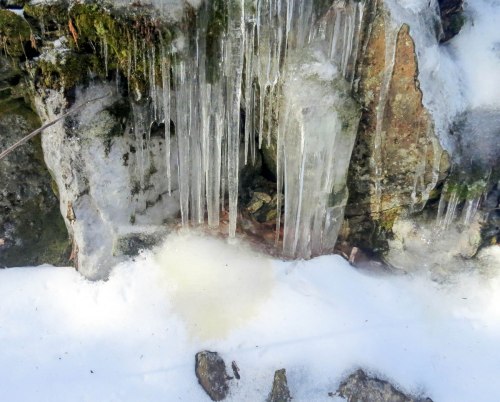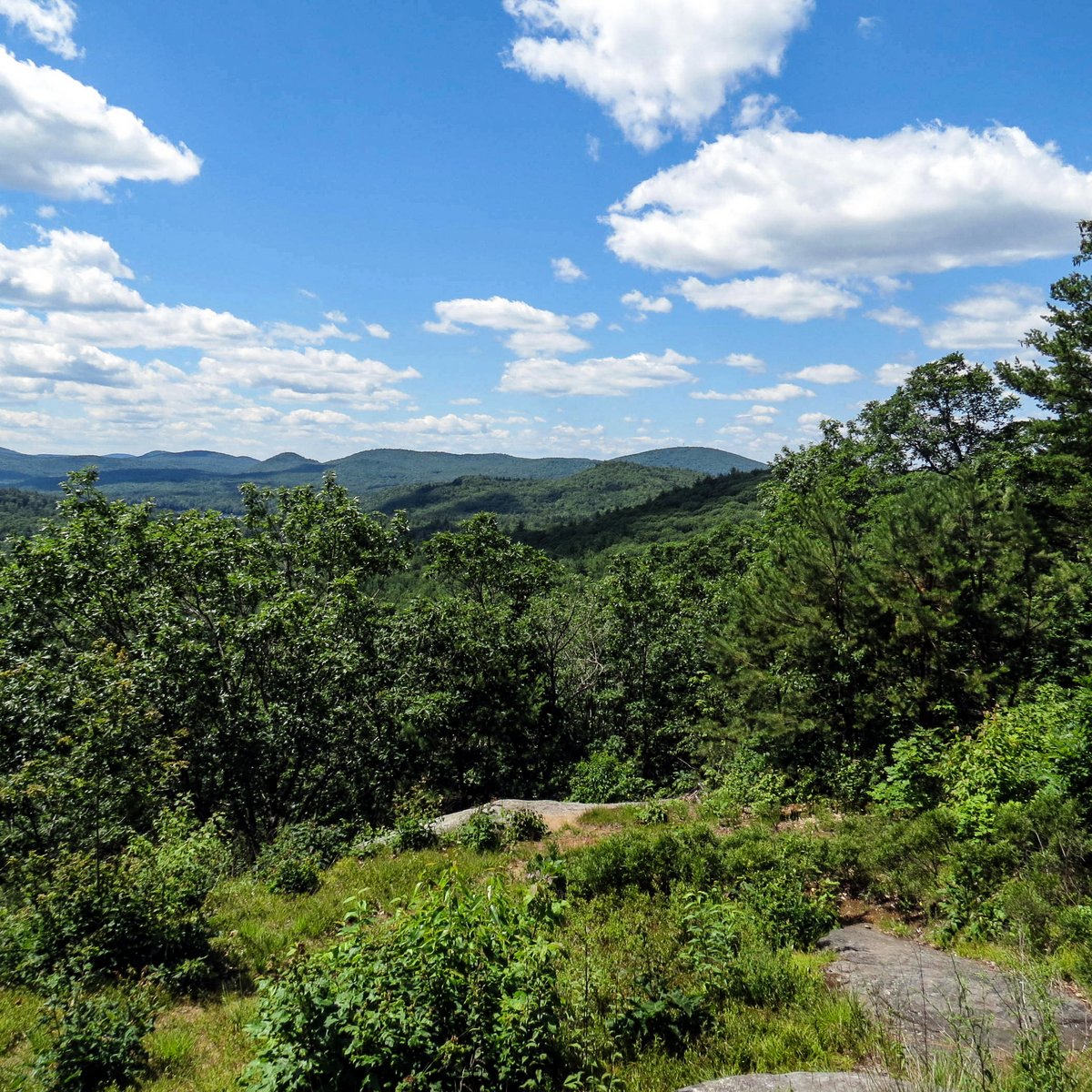
I’ve wanted to visit the cranberry meadow pond trail in Peterborough since it was built a few years ago but somehow, I never made it. It isn’t far, just a half hour away to the east of Keene, so last week I decided to finally go and see it. Since this is in a county other than Cheshire County where I live, this trip was part of my new branching out plan. The trail begins with a raised boardwalk through a wetland.

On this day the wetland the boardwalk crosses was very wet but I could tell by red maples standing in a foot of water that it isn’t always this wet. It looked like the stream that runs through here flooded from heavy rains we had a few days before. What a beautiful day it was.

The boardwalk is sturdily built and wide enough for two people to pass. Building it was obviously a lot of work, so hat’s off to the builders. I think it was built three or four years ago, and it has stood up well.

At the end of the boardwalk were planks to help get you through the muddy spot. There are many muddy spots along the trail so you should wear sturdy, waterproof hiking boots if you come here. You can also see in this shot a blue diamond blaze on the tree ahead. The trail is well blazed with these markers.

But really, on this section of trail you don’t need blazes because you’re simply following a steam to its source. Since I’ve been following rivers and streams for all of my life it seemed obvious, but for someone who hasn’t done that maybe the blazes are a good idea.

I saw what I can only describe as tenderness being displayed by a family of cinnamon ferns, but that’s just my interpretation. Cinnamon and interrupted ferns are usually the first to show their fiddleheads in spring.

There were lots of striped maples (Acer pensylvanicum) here that had reached a good age. I don’t see many large striped maples like these. The bark gives their name away.

There were lots of beech trees, too. I looked for the arching of buds that signals bud break, but saw just a few getting ready.

In case you don’t know what bud it is you’re seeing someone has marked the tree for you. They didn’t bother with the Fagus grandifolia part of the name though, which is probably a good thing for the tree.

At this point you have to cross the stream. It’s always nice to have the laughter of a stream to keep you company on a walk through the woods. This one is very easy to get close to over most of its length and that made an enjoyable walk even more so.

Stone walls hint that this was once pasture land, and the young age of most of the trees found here confirms it. This was a common “thrown” or “tossed” wall, built only to get the stones out of the way as quickly as possible. Though they often followed boundary lines they weren’t built for pretty. It was hard, back breaking work but if you wanted to grow crops it had to be done, and with our short growing season, the sooner the better.

There are some huge boulders here and there, some with polypody ferns and others with rock tripe lichens growing on them. This one was covered with mostly moss and a few trees. If you pay attention to the plants and trees that choose to grow on boulders like this one you realize how shallow their root systems must be. There can’t be more than an inch of soil on some of the big stones, but it is enough. Mosses usually colonize first and soak up rain water like a sponge, and then the larger plants growing near or with them benefit from their slow release of water. I’ve even seen dandelions growing on stone, even though they have a root like a carrot.

There were some nice reflecting pools in this little stream. It’s amazing how moving water can appear so still sometimes. Several times I thought of my father on this hike because he loved to fish for brook trout in places like this. Actually I’ve always thought his love of fishing was secondary to his love of simply being in places like this.

Here was another muddy spot. No trouble at all if your boots are waterproof.

I saw a tiny yellowish smudge on a birch log. The camera’s zoom brought it closer and I couldn’t believe what I was seeing.

It was a pretzel slime mold (Hemitrichia serpula) producing spores. The furryness or fuzziness of it is what shows that it was in the fruiting stage, actively producing spores. If I had found it a day or two earlier it would have been in its plasmodial stage, shiny and smooth like plastic. I had been hoping to see one for years, so it was an exciting find. They are usually small; all of what you see here fit in what was maybe a square inch of space. If you’re interested there is a good short video explaining what this slime mold is all about here: https://www.youtube.com/watch?v=R2RguYFuiM8

The trail started to climb uphill, but not steeply. This is the part of the trail where you leave the stream you’ve been following.

Once the trail leveled off again it was easy to picture it as pasture land. All the trees were very young.

There were some old grape vines growing up into the treetops. River grapes most likely, but they might have been Concord grapes, which also grow wild here. Before we started cultivating them and training them, this is how grapes grew naturally. They seek as much energy giving sunshine as possible and this leads them into the treetops. If you are mindful of how valuable sunlight is to plants when you walk through the woods, you’ll see all the various ways they maneuver themselves into position to recieve the most light. They all have different strategies that they have developed over who knows how many years of evolution, and some might surprise you. Plants that don’t climb, like native hobblebushes for instance, have developed other ways of finding light. They grow large, light gathering leaves. Other plants grow taller and lean into the light to get their share, just like that bean plant you probably grew on the window sill in first grade did. By the way, you were supposed to be learning about phototropism in that experiment, so I hope you were paying attention.

And here was the source of the stream; Cranberry meadow pond. Though I met quite a few people on the trail, which was a surprise on a weekday, for the most part you have the place to yourself. The pond is large and does have at least one house on it that I saw, and there is more building going on nearby. Since I had to see everything there was to see I dawdled and was here for about two and a half hours, but I think you could easily get to the pond and back to your car in an hour. But you’d miss a lot if you did, so dawdle a little. The trail map says it is one mile to the pond from the parking area but my phone said 1.3. Either way it isn’t much. You can go on from here all the way to the top of Pack Monadnock Mountain, another 1.2 miles, but I stopped here at the pond. When mushrooms start appearing I’ll be back because I have a feeling that this will be a great place to find them.

I saw one of the oldest, gnarliest blueberry bushes that I’ve ever seen here. It had a girth on its lower trunk as big as my leg. This scene showed how you can often pick the most blueberries from a boat. Ponds and lakes in this region have wild blueberry bushes growing all along their shorelines.

And the old blueberry was loaded with buds. When young, blueberry buds are bright red but as they grow in spring they swell up and lose their red color.

I saw beaver damage on trees all the way up here and here was the source of it; a large beaver lodge. It’s hard to find a pond or river in New Hampshire that doesn’t have beavers in it. What surprised me most here was the lack of damming of the stream.

There’s the beaver lodge again, just to the left of center out on the shoreline. This view also shows a small very flat island, which could be a bog mat made of peat mosses. I was surprised that I didn’t see any cranberry plants here but since most of the trail was wooded, I shouldn’t have been. They like full sun.
If you’re a lover of solitude this is the place for you, but if on the other hand you want to have a family picnic this would be a great place for that, too. The land the trail is on is privately owned and the land owners graciously allow public use, so the best way to keep it open is to always leave it as you find it. You can find out more about the trail and download a trail map by Googling “Cranberry Meadow Pond Trail, Perterborough, NH” or by clicking on the underlined text.
Pleasure is spread through the earth in stray gifts to be claimed by whoever shall find them. ~William Wordsworth
Thanks for stopping in.

























































































































